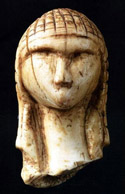Anthropology, Department of

Department of Anthropology: Faculty Publications
Document Type
Article
Date of this Version
2006
Abstract
Human coprolites, dating from 8,500 to 7,000 years BP, were collected from the rock-shelter of Boqueirão da Pedra Furada, in Piauí, Brazil. These dates fall within the “Serra Talhada” cultural traditions I and II of the Tradição Nordeste, a paleohuman culture of northeastern Brazil. Archaeoparasitological analysis of the coprolites revealed whipworm eggs and hookworm eggs. Analysis of Tradição Nordeste skeletons and hair shows a variety of diseases including dental problems, osteoarthritis, and head louse infestation. Palynological analysis of the coprolites revealed 12 genera that were potentially medicinal. The pollen data were critically analyzed to assess the potentiality that the pollen represented medicinal use. Strong cases could be made that three of the genera, Anacardium, Borreria, and Terminalia, were actually used for medicinal purposes, probably to treat symptoms caused by the intestinal parasites.


Comments
Published in Palaeogeography, Palaeoclimatology, Palaeoecology 237 (2006) 110 –118. Copyright 2006, Elsevier. www.elsevier.com/locate/palaeo. doi:10.1016/j.palaeo.2005.11.031. Used by permission.